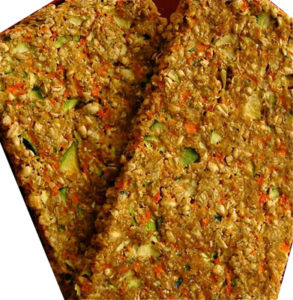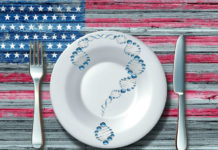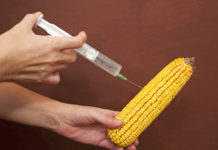Raw Food and Dehydrators
The Physiology of Chewing!
My first experience of the raw food lifestyle was at the Optimum Health Institute in San Diego, where I eventually become a resident and teacher. The OHI program began with an intensive juice “feast” or fast for cleansing and detoxifying the body. I had two responses to my first juice feast. First, I never experienced such an energy boost in my life. I went from being chronically fatigued to having more energy than I knew what to do with!
The other response was a noticeable nostalgia for crunchy foods that required some real chewing. Of course, at OHI they tell you to “chew your drinks and drink your solids,” an admonition to chew everything you eat or drink, stimulating production of saliva and increasing the efficiency of the first stage of digestion. But that’s a lot easier to talk about than to remember to do with every sip of juice. Most importantly, it was the first glimmer I was having into the importance of chewing to our minds as well as our bodies.
You see, chewing is more than just a means of digestion. It is so important to our health that we are psychologically wired with a need to chew! We see that in our pets and even our children, but we seem to forget how important the simple act of chewing is to us all.
Take chewing gum, for example. You would think gum is nothing more than a candy with no health value at all, breath freshening aside. But it turns out that the simple act of chewing gum actually improves out state of mind. It’s not something in the gum – it’s the act of chewing! A team of psychologists at St. Lawrence University gave 159 students a battery of cognitive tasks – and those randomly assigned to gum-chewing significantly outperformed those in a control group on five out of six tests. (1)
Mastication-Induced Arousal
There is actually a real name for this phenomenon: “mastication- induced arousal.” There isn’t a whole lot of scientific evidence about the psychological importance of chewing, but the St. Lawrence definitely definitely shows that there is something there. Perhaps we’ve been wired that way to make sure we chew food rather than just wolf it down, improving the first stage of digestion. Maybe it is part of our survival instincts, making us more alert for predators and scavengers that might have designs on our latest catch. In this study we only have begun to study mastication induced behaviors.
induced arousal.” There isn’t a whole lot of scientific evidence about the psychological importance of chewing, but the St. Lawrence definitely definitely shows that there is something there. Perhaps we’ve been wired that way to make sure we chew food rather than just wolf it down, improving the first stage of digestion. Maybe it is part of our survival instincts, making us more alert for predators and scavengers that might have designs on our latest catch. In this study we only have begun to study mastication induced behaviors.
So there I was at OHI for the very first time — and with a definite need chew. But almost all I was getting was raw veggie juice or, as some call a salad, “rabbit food.” Now OHI was telling me that I was supposed to chew my juice and drink my solids – and even a salad requires some chewing. But I believe that there are different kinds of chewing! Chewing a liquid or even my rabbit food just never had the same satisfaction for me as chewing popcorn or chips!
I eat a large raw salad almost every single day, but raw food doesn’t have the “crunch factor.” Sprouts are healthy and delicious but no significant “crunch.” Raw nuts, which ideally should be soaked, are then crunch-free. Greens – no crunch. Carrots have some crunch but not quite at the level of crunchiness you get from chips or toast. We need more than just any ol’ chewing – we need to chew something crunchy! And that is where the wonders of dehydrators can help!
 You see, dehydrators bridge the gap between rabbit foods and the crunchy, cooked foods we are all so addicted to. That is why dehydrated raw foods are sometimes called “transitional” by raw foodists. You see, you take something raw, dehydrate it at under 118°F and turn it into a raw cracker, chip, treat or “bread” without destroying all the enzymes and giving it substantial crunch appeal. When I was first served dehydrated flax seed crackers at OHI, I was in heaven. Now I could really “get my teeth” into raw food!
You see, dehydrators bridge the gap between rabbit foods and the crunchy, cooked foods we are all so addicted to. That is why dehydrated raw foods are sometimes called “transitional” by raw foodists. You see, you take something raw, dehydrate it at under 118°F and turn it into a raw cracker, chip, treat or “bread” without destroying all the enzymes and giving it substantial crunch appeal. When I was first served dehydrated flax seed crackers at OHI, I was in heaven. Now I could really “get my teeth” into raw food!
What you Need to Know to Buy a Dehydrator
Dehydrators serve many purposes in addition to their nutritional benefits or for food preservation. With a dehydrator you can make it easier to overcome old, entrenched food addictions. Or if cooking is your passion you can replace the stove top and oven with a dehydrator and get even more enjoyment from un-cooking! And finally, with a dehydrator you can make an important but radical lifestyle change to more raw food in your diet much, much easier.
Types of Dehydrators
All the dehydrators I am writing about are electric models. You can also buy or build your own solar dehydrators. However, solar dehydrators are not ideal for raw foods because it can be difficult to control temperatures without an electric thermostat. Temperature control is essential to dehydrated raw foods because one of the big ideas behind raw is living enzymes. Enzymes die at temperatures above118°F, so you cannot let your dehydrator get above that. Believe it or not, a solar dehydrator can get much hotter, especially in southern climes or anywhere on a hot, sunny day.
With electric dehydrators there are two basic designs – vertical and horizontal. Since horizontal airflow dehydrators have much better temperature control and efficiency I only recommend these models. Vertical designs are less expensive and have stackable trays, which is convenient. However their heaters are usually located at the bottom of the unit, creating uneven heating between the bottom and top of the units. If you already have one of these, and it has a temperature control (some don’t), then you can use it to get started, but you should use a separate candy or yogurt thermometer to be sure of the internal temperatures and you will need to rotate the bottom and top trays every few hours to get even heating.
Horizontal Airflow Dehydrators

Horizontal dehydrators are rectangular-shaped boxes with 4 to 12 or more trays stacked inside the unit that slide in and out. All these units have one or two fans at the back of the unit that blow air “horizontally” across the trays, creating a much more efficient airflow with more even heating. There are 4 main types of these dehydrators:
- Economy models with just a simple thermostat and 4, 5, 9 or 10 trays
- Deluxe models with heavy duty motors, heaters and thermostats
- Digital models with computer controlled thermostats and/or timers
- Professional-quality or commercial models made of stainless steel

Excalibur Dehydrators
The first horizontal airflow design was invented by Excalibur Dehydrators, and was called the Parallexx™. The square design provides more even, faster drying and increases drying area 25% over round models. Excaliburs are available in economy and heavy-duty models with 4, 5 or 9 trays. Excalibur dehydrators are made right here in the USA.
TSM Dehydrators
 TSM (“The Sausage Maker)” is one of the world’s leading sources for meat processing equipment, including some of the finest dehydrators for home and commercial kitchens. They began over 30 years ago and virtually all of the equipment they manufacture are made and designed in the USA by TSM in Buffalo, New York. TSM stainless steel dehydrators are available in deluxe home models as well as large-capacity, all digital commercial units.
TSM (“The Sausage Maker)” is one of the world’s leading sources for meat processing equipment, including some of the finest dehydrators for home and commercial kitchens. They began over 30 years ago and virtually all of the equipment they manufacture are made and designed in the USA by TSM in Buffalo, New York. TSM stainless steel dehydrators are available in deluxe home models as well as large-capacity, all digital commercial units.
Tribest Dehydrators
 Though Tribest began making some of the world’s best masticating juicers over 30 years ago, they only recently entered the dehydrator market. However, they really did their homework before jumping in, designing one of the most innovative and feature-packed, and digitally controlled dehydrators available. The Tribest Sedona 9-tray Dehydrator is a real winner, though the most expensive of the molded plastic units out there. It features a 9-tray design that can be divided into two 4-tray sections, with a solid divider tray between them – each with its own fan and digital controls. Not only does this eliminate the need to rotate trays, it allows you to dehydrate two entirely different recipes using different temperatures at the same time.
Though Tribest began making some of the world’s best masticating juicers over 30 years ago, they only recently entered the dehydrator market. However, they really did their homework before jumping in, designing one of the most innovative and feature-packed, and digitally controlled dehydrators available. The Tribest Sedona 9-tray Dehydrator is a real winner, though the most expensive of the molded plastic units out there. It features a 9-tray design that can be divided into two 4-tray sections, with a solid divider tray between them – each with its own fan and digital controls. Not only does this eliminate the need to rotate trays, it allows you to dehydrate two entirely different recipes using different temperatures at the same time.
What Makes a Dehydrator Work?
Horizontal Shape
Horizontal airflow dehydrators are the only designs I consider appropriate for living, raw food enthusiasts due to the importance of temperature control – also, better airflow and faster drying times inhibit growth of molds and other organisms. These units are basically just rectangular or square boxes with several removable trays stacked inside about 1.75 inches apart. Horizontal airflow dehydrators have one or two fans in the back of the unit blowing warm air over the tops of the trays for better temperature control and efficiency.
The Trays
Horizontal airflow dehydrators are the only units I consider appropriate for living, raw food enthusiasts due to the importance of temperature control for protecting the living enzymes in raw foods. Better airflow and faster drying times also inhibit growth of molds and other organisms. These units are basically just rectangular or square boxes with several removable trays stacked inside about one to two inches apart. Horizontal airflow dehydrators have fans in the back blowing warm air over the tops of the trays for better temperature control and efficiency. The trays themselves are a wide-grid type made of plastic or stainless steel. A “mesh” screen like material is placed over the trays to keep things from falling through the grid. Alternatively, drying sheets made of unbleached parchment paper, silicone or a Teflon-like, non-stick materials are used when dehydrating batters or purees for crackers, breads or fruit leathers. You can remove several trays at a time to make room for small jars when making yogurt, as well.
Heater & Fan Assembly

The main purpose of a dehydrator is to blow heated air across the trays and whatever produces you put on the trays. The air is heated by a heating element using electronic resistance and then blown by a large fan. The heating element is usually just a spring-shared wire that heats up when turned on. All the horizontal airflow dehydrators have at least a thermostat to control the drying temperature by adjusting the current in the heating element. Most dehydrators operating in the range of 85 to 150 degrees F., however always remember that for raw food, enzymes are completely destroyed at temps above 118°F.
Thermostats in dehydrators on not extremely accurate since they are relatively open to increase airflow and not tightly sealed like an oven. However, they give an approximate range that is close enough for our purposes. For more accurate calibration you can use a candy or yogurt thermometer placed inside the unit to know the precise temperature. This is an important step when drying very wet items since evaporation inside a dehydrator can low internal temperatures by 10 to 20 degrees. In those cases you’ll want to increase the temperature for the first few hours even above the 118°F max to speed up initial stages of drying and the minimize to potential for mold.
Most 4, 5, 6 or 10 tray dehydrators have a single fan at the back. Smaller units have a small fan around 5 or 6 inches in diameter. They are usually 400-500 watts. The larger 9 or 10 tray models can have one or two fans in the back, improving airflow and control. These are usually around 600-800 watts.

Thermostats & Timers
There are basically just two types of controls for dehydrators – manual and automatic or digital. Economy models simply have a manual thermostat, which you set by hand. Some better models offer a manual timer as well, like a built-in kitchen timer. Generally these are limited to a relatively short time period of 12- 24 hours – often not enough for dehydrating some raw food recipes. However, I often tell people on a budget to get a model without the timer, then just plug it into a standard heavy-duty kitchen appliance timer that you can buy online for under $20.00.
Better models offer built-in digital timers. The low cost digital models have up to 40 hours on their timers, which is enough for most things. The best models are completely automatic, digital and computer-controlled with up to 99 hours of programmable timing.
A timer can be a two-edged sword. You see, I think it is better to be aware and conscious when you a dehydrating – checking the trays regularly to make sure the process is going as planned. In some cases you may need to raise and lower temperatures a bit. Sometimes your timer can be set too long and you’ll over dry items. Worse, an automatic timer can turn a unit off if you aren’t careful before it is completely dry, leaving food on open-air trays in a warm, moist environment – a good formula for molds and fermentation! So even if you do have a fancy, computer-controlled timer, stay conscious and aware during the entire process and check your dehydrator regularly.
BPA-Free Plastics and Other Materials
Dehydrators can be made of several different types of plastics or, in more expensive models, stainless steel. Of the different plastics available, these break down into two families – standard “food-grade” plastics and BPA-Free plastics. BPA-free plastics are the latest craze online and in the media, however with dehydrators it is an over-hyped concern.
You see, BPA in plastics that have BPA’s do not out-gas at the temperatures used in a dehydrator. In fact, it takes hundreds of degrees to get any plastic to out-gas BPA. Even the leader in the field, Excalibur, doesn’t use BPA-Free plastics because they chose the best plastic for strength and durability first rather than settling only on those that catered to customers concerned about BPA-free products.
Excalibur uses two plastics in their designs, including polypropylene, considered the safest plastic around food, and polycarbonate for the case because it is virtually indestructible. FDA-approved polycarbonate is considered completely safe when used at the low temperatures inside a dehydrator.
“The use of polycarbonate plastic for food contact applications has been and continues to be recognized as safe by the U.S. Food and Drug Administration, the European Commission’s Scientific Committee on Food, the United Kingdom Food Standards Agency, the Japanese Ministry of Health, Labor and Welfare, and other regulatory authorities worldwide. (2)
The concern about the safety of polycarbonates started in 1999 when the TV show 20/20 reported a warning from Consumer Reports about polycarbonate baby bottles releasing biphenyl-A (BPA), a chemical used in making polycarbonate. However, this only happened when microwaving or boiling polycarbonate baby bottles, repeatedly subjecting them to temperatures over 250 degrees F., which can never happen in dehydrators. Newer models, like the Tribest Sedona do use BPA-free materials in their trays and screens. And, of course, the safest material for any kind of food processing is always stainless steel.
How to Buy a Dehydrator
The first thing I always tell folks is to get the biggest dehydrator they can afford (assuming, of course, you have the space to store it nearby). For most people that is a 9 or 10-tray model, featuring 10-12 sq. ft. of drying area. Smaller 4 or 5 tray models, with less than half the drying area, are only recommended when you don’t have the space for anything bigger. You see, the prep time and drying time is just about the same whether you are doing 12 square feet or less than a third of that! So you might as well make two or three times as much of your favorite recipe at one time, actually saving you money in the long run. Dehydrated items can become a staple in a raw food diet, so making it easier and more efficient to dehydrate goes a long way in making it easier to adapt to a raw food lifestyle.
Other Considerations
Cleaning – All horizontal airflow dehydrators have removable trays. Some trays however are much large than the average kitchen sink, making them harder to clean. Measure you sink and check the size of the trays for the easiest cleaning. Even with over-size trays, however, cleaning isn’t much more difficult than with smaller trays.
Counter Space – try to buy a dehydrator that is easy to store in your kitchen. If you have to go all the way out to a garage to dig it out, chances are it will get less use. Of course, lots of people do all their dehydrating in the garage. Some models are particularly noisy, and when running all day can keep you up at night. In that case a garage is nice. More recent designs these days are a lot quieter, like the Tribest Sedona. However, the noise factor never bothered me personally and I prefer to just do everything in the kitchen. I bought one of those little rolling kitchen islands with a marble top online for a very reasonable price. It has a bottom shelf just the right size to store my dehydrator. Now all I have to do is put it up on the counter and it’s ready to use.
Slicing – If you don’t already have a vegetable mandolin you should get one when you buy your dehydrator. Unless you have the skills of a great chef, carving perfectly regular slices with a knife is going to be beyond your skill-set. A mandolin makes precise slices that will ultimately save hours of your time. For example, a 2mm veggie slice could dry 33%-50% faster than a 3mm slice! I always recommend getting the Teflon-type non-stick sheets with a dehydrator. However, it is possible to use unbleached parchment paper instead, which is very inexpensive online.
References
- Lehrer, Jonah, Cognitive Benefits Of Chewing Gum, Wired Magazine. 11/29/2011
- www.Excalibur.com
By Robert Ross, Jan. 2012 (Updated March, 2017)
















